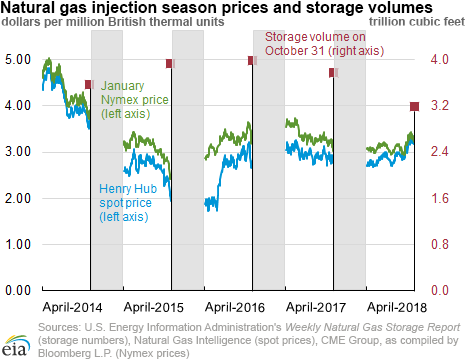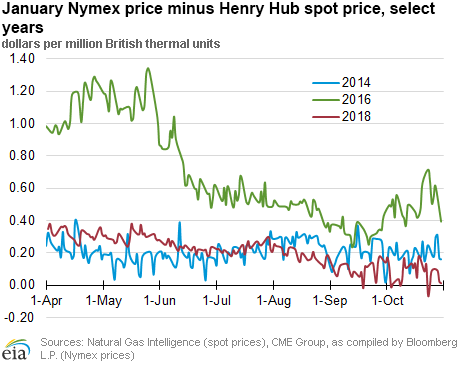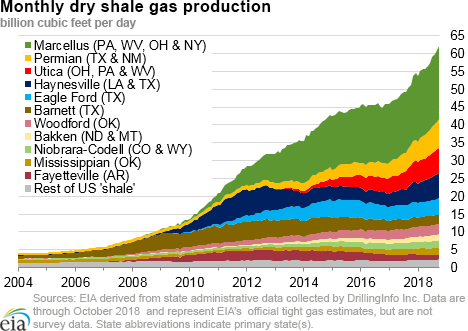In the News:
January 2019 Nymex prices remain close to spot prices throughout the 2018 injection season
The difference or spread between this summer’s spot natural gas prices at the Henry Hub and the New York Mercantile Exchange (Nymex) natural gas futures prices for January 2019 has been small since April. During the 2018 injection season—traditionally defined as April through October—the difference between summer (2018) spot and January (2019) natural gas futures prices averaged about 20¢ per million British thermal units (MMBtu), the narrowest price spread since 2014.
This seasonal price spread was relatively low despite a historically low end-of-October natural gas storage inventory of 3,189 billion cubic feet (Bcf). By comparison, in 2016 the seasonal spread averaged 69¢/MMBtu, and the natural gas inventory was at a record end-of-season storage volume of 3,986 Bcf.
Summer-winter price spreads can affect the economics of using natural gas storage services to manage seasonal swings in prices. When injection-season spot prices are closer to winter futures prices, traders have less economic incentive to store natural gas, particularly because of the fees associated with keeping natural gas in storage.
During most of the injection season, record production levels—and expectations that they will be sustained going forward—moderated expectations for mid-winter natural gas prices while high demand raised summer spot gas prices, causing the summer-winter price spread to narrow. Henry Hub spot prices remained lower than $3.00/MMBtu for most of the 2018 injection season, but sharply increased to an average of $3.25/MMBtu in October as the United States experienced a period of significantly-colder-than-normal fall weather. January Nymex prices also rose with the spot prices, but the differential between the two shrank to an average of 8¢/MMBtu in October, and on some days the differential was negative.
Since the end of the injection season, spot prices have increased further, averaging $3.70/MMBtu as of November 14. The January futures prices have also risen, and on a number of days, January futures were lower than spot prices, which translates to a spot-future differential that has averaged 4¢/MMBtu.
Overview:
(For the Week Ending Wednesday, November 15, 2018)
- Natural gas spot prices rose at most locations this report week (Wednesday, November 7 to Wednesday, November 14). Henry Hub spot prices rose from $3.51/MMBtu last Wednesday to $4.59/MMBtu yesterday.
- At the Nymex, the December 2018 contract price rose $1.28 from $3.555/MMBtu last Wednesday to $4.837/MMBtu yesterday.
- Net injections into working gas totaled 39 Bcf for the week ending November 9. Working natural gas stocks are 3,247 Bcf, which is 14% lower than the year-ago level and 16% lower than the five-year (2013–17) average for this week.
- The natural gas plant liquids composite price at Mont Belvieu, Texas, fell by 60¢/MMBtu, averaging $6.95/MMBtu for the week ending November 14. The price of natural gasoline, propane, butane, and isobutane fell by 11%, 11%, 12%, and 10%, respectively. The price of ethane rose by 3%.
- According to Baker Hughes, for the week ending Tuesday, November 6, the natural gas rig count increased by 2 to 195. The number of oil-directed rigs rose by 12 to 886. The total rig count increased by 14, and it now stands at 1,081.
Prices/Supply/Demand:
The national benchmark average spot price increases for the fifth straight week. Prices around the country generally increased with cooler weather and increased heating demand. This report week (Wednesday, November 7 to Wednesday, November 14), Henry Hub spot prices rose $1.08 from $3.51/MMBtu last Wednesday to a weekly high of $4.59/MMBtu yesterday. This is the highest Henry Hub spot prices have been since January 2018. At the Chicago Citygate, prices increased 93¢ from $3.68/MMBtu last Wednesday to $4.61/MMBtu yesterday.
Prices at Sumas on the Canada-Washington border have remained volatile following an Enbridge pipeline explosion in October. Prices fell $4.16 from a weekly high of $18.10/MMBtu last Wednesday to $13.94/MMBtu yesterday as U.S. imports from Canada at the border continue to remain around 0.5 billion cubic feet per day (Bcf/d) according to Genscape data, or roughly half of their pre-explosion levels.
California prices increase despite demand destruction as the state battles several fires. Prices at PG&E Citygate in Northern California rose $1.28, up from $4.00/MMBtu last Wednesday to a weekly high of $5.28/MMBtu yesterday. According to PG&E, as of yesterday approximately 23,000 electric customers and 12,000 natural gas customers are without service because of the Camp Fire, located approximately 90 miles north of Sacramento, California.
Prices at SoCal Citygate increased $3.51 from $4.98/MMBtu last Wednesday to a weekly high of $8.49/MMBtu yesterday. According to Southern California Edison, as of yesterday approximately 6,600 customers were without power because of the Woolsey Fire and the Hill Fire, which are burning northwest of Los Angeles.
Northeast prices increase. At the Algonquin Citygate, which serves Boston-area consumers, prices went up $6.40 from $3.76/MMBtu last Wednesday to $10.16/MMBtu yesterday. At the Transcontinental Pipeline Zone 6 trading point for New York City, prices increased $1.57 from $3.55/MMBtu last Wednesday to $5.12/MMBtu yesterday.
Tennessee Zone 4 Marcellus spot prices increased $1.12 from $3.37/MMBtu last Wednesday to $4.49/MMBtu yesterday. Prices at Dominion South in southwest Pennsylvania rose $1.10 from $3.30/MMBtu last Wednesday to $4.40/MMBtu yesterday.
Discount at Permian Basin trading hub persists. Prices at the Waha Hub in West Texas, which is located near Permian Basin production activities, averaged $1.19/MMBtu last Wednesday, $2.32/MMBtu lower than Henry Hub prices. Yesterday, prices at the Waha Hub averaged $3.42/MMBtu, $1.17/MMBtu lower than Henry Hub prices.
Nymex front month futures prices increase to highest levels since 2014. At the Nymex, the price of the December 2018 contract increased $1.28, from $3.555/MMBtu last Wednesday to a weekly high of $4.837/MMBtu yesterday. This is the highest price for a front month contract since February 2014, which was an unseasonably cold winter with low inventory levels. The price of the 12-month strip averaging December 2018 through November 2019 futures contracts climbed 45¢/MMBtu to $3.426/MMBtu.
Supply flat as Canadian imports increase. According to data from PointLogic Energy, the average total supply of natural gas remained the same as in the previous report week, averaging 91.3 Bcf/d. Dry natural gas production decreased by 1% compared with the previous report week. Average net imports from Canada increased by 19% from last week. Much of this increase can be attributed to increased U.S. imports from Canada at Waddington in upstate New York, as the 1.1 Bcf/d Iroquois pipeline is currently flowing at capacity, up from zero the week prior.
Demand rises significantly with higher consumption in the residential/commercial sectors. Total U.S. consumption of natural gas rose by 27% compared with the previous report week, according to data from PointLogic Energy, as cooler-than-normal weather blanketed most of the Lower 48 states. This increase was led by the residential and commercial sectors, where consumption increased by 58%. Natural gas consumed for power generation climbed 16% week over week. Industrial sector consumption increased by 7% week over week. Natural gas exports to Mexico decreased 2%.
Natural gas feedstock deliveries to U.S. LNG liquefaction facilities increase week over week. Combined natural gas feedstock deliveries to all U.S. LNG liquefaction facilities have averaged 4.3 Bcf/d over the last week, compared to 4.0 Bcf/d the previous week, according to data from IHS Markit OPIS PointLogic Energy, as developers continue commissioning activities of the new liquefaction trains, including Sabine Pass Train 5, Corpus Christi Train 1, and Cameron LNG Train 1. Cheniere Energy, the developer of Sabine Pass and Corpus Christi liquefaction terminals, stated that the first LNG from Train 5 at Sabine Pass was produced in late October, and from Corpus Christi’s Train 1 on November 14. Corpus Christi will be the third U.S. LNG liquefaction terminal placed in service, after Sabine Pass and Cove Point. An LNG vessel has been moored at the Corpus Christi’s terminal berth to load the first LNG cargo from Train 1 since Sunday, according to SP Global Platts.
Storage:
Net injections are higher than the five-year average. Net injections into storage totaled 39 Bcf for the week ending November 9, compared with the five-year (2013–17) average net injections of 19 Bcf and last year's net withdrawals of 13 Bcf during the same week. Working natural gas stocks totaled 3,247 Bcf, which is 601 Bcf lower than the five-year average and 528 Bcf lower than last year at this time.
Working gas stocks’ deficit to the five-year average and deficit to the bottom of the five-year range decrease. In the Lower 48 states, total working gas stocks are 359 Bcf lower than the five-year minimum, and every storage region is currently lower than the bottom of the five-year range. The deficit to the bottom of the range decreased in all regions except the South Central nonsalt region. As of this report week, the Midwest region is 69 Bcf (6%) lower than the five-year minimum, and the South Central region―including both salt and nonsalt facilities―is 145 Bcf (13%) lower than the five-year minimum.
The average January 2019 futures contract price is trading at a lower premium to the average spot price than last year at this time. Price differences between the spot price and the futures price at the Nymex indicate limited economic incentives for injections into working gas. During the most recent storage week, the average natural gas spot price at the Henry Hub averaged $3.47/MMBtu, and the Nymex futures price of natural gas for delivery in January 2019 averaged $3.52/MMBtu, 5¢/MMBtu higher than the spot price. A year ago, the January contract was 24¢/MMBtu higher than the spot price.
Reported net injections into storage are slightly higher than the median of analysts’ expectations. According to The Desk survey of natural gas analysts, estimates of the weekly net change from working natural gas stocks ranged from net injections of 22 Bcf to 47 Bcf, with a median estimate of 34 Bcf. At the 10:30 a.m. release of the Weekly Natural Gas Storage Report, the price of the Nymex futures contract for November delivery at the Henry Hub fell 2¢/MMBtu to $4.27/MMBtu, with only 127 trades executed. The price varied in subsequent trading, averaging $4.28/MMBtu.
Temperatures are warmer than normal for the storage week. Temperatures in the Lower 48 states averaged 52 degrees Fahrenheit (°F), 2°F higher than normal and the same as last year at this time. Temperatures were 2°F lower than those reported for the previous week.
See also:
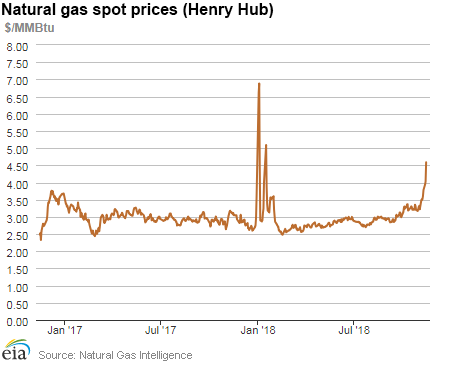
| Spot Prices ($/MMBtu) | Thu, 08-Nov |
Fri, 09-Nov |
Mon, 12-Nov |
Tue, 13-Nov |
Wed, 14-Nov |
|---|---|---|---|---|---|
| Henry Hub |
3.61 |
3.78 |
3.94 |
4.04 |
4.59 |
| New York |
3.46 |
3.98 |
3.96 |
4.43 |
5.12 |
| Chicago |
3.77 |
3.92 |
4.04 |
4.06 |
4.61 |
| Cal. Comp. Avg.* |
3.62 |
3.72 |
4.25 |
4.47 |
5.05 |
| Futures ($/MMBtu) | |||||
| December contract | 3.543 |
3.719 |
3.788 |
4.101 |
4.837 |
| January contract |
3.553 |
3.721 |
3.800 |
4.147 |
4.898 |
| *Avg. of NGI's reported prices for: Malin, PG&E Citygate, and Southern California Border Avg. | |||||
| Sources: Natural Gas Intelligence and CME Group as compiled by Bloomberg, L.P. | |||||
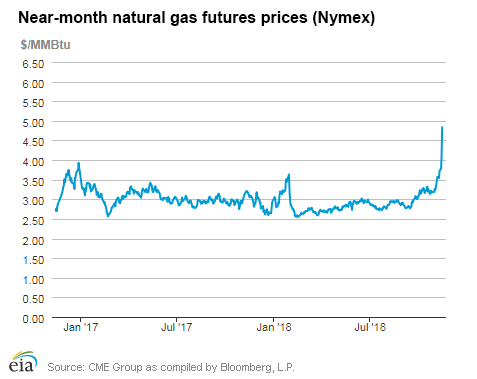
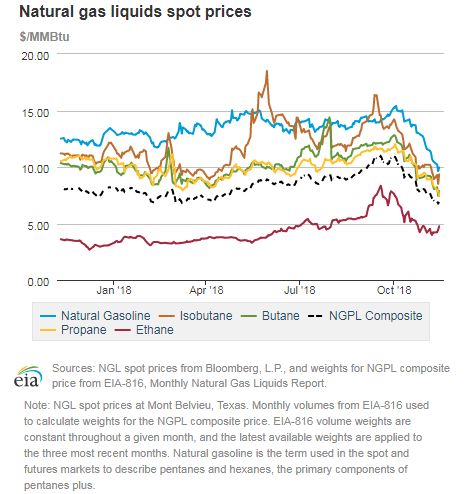
| U.S. natural gas supply - Gas Week: (11/8/18 - 11/14/18) | |||
|---|---|---|---|
Average daily values (Bcf/d): |
|||
this week |
last week |
last year |
|
| Marketed production | 96.9 |
97.6 |
86.1 |
| Dry production | 87.0 |
87.5 |
78.0 |
| Net Canada imports | 4.2 |
3.5 |
6.3 |
| LNG pipeline deliveries | 0.1 |
0.1 |
0.2 |
| Total supply | 91.3 |
91.1 |
84.5 |
|
Source: OPIS PointLogic Energy, an IHS Company | |||
| U.S. natural gas consumption - Gas Week: (11/8/18 - 11/14/18) | |||
|---|---|---|---|
Average daily values (Bcf/d): |
|||
this week |
last week |
last year |
|
| U.S. consumption | 86.5 |
67.8 |
78.9 |
| Power | 25.5 |
22.0 |
23.0 |
| Industrial | 24.2 |
22.5 |
23.3 |
| Residential/commercial | 36.8 |
23.3 |
32.5 |
| Mexico exports | 4.6 |
4.7 |
4.5 |
| Pipeline fuel use/losses | 8.2 |
6.4 |
7.4 |
| LNG pipeline receipts | 4.3 |
4.0 |
2.9 |
| Total demand | 103.5 |
83.0 |
93.7 |
|
Source: OPIS PointLogic Energy, an IHS Company | |||
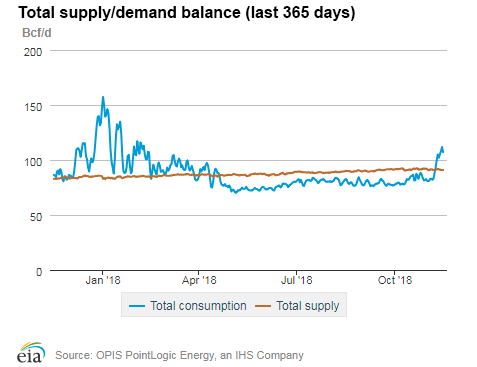
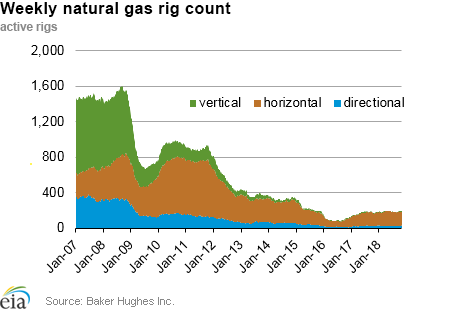
| Rigs | |||
|---|---|---|---|
Tue, November 06, 2018 |
Change from |
||
last week |
last year |
||
| Oil rigs | 886 |
1.4% |
20.1% |
| Natural gas rigs | 195 |
1.0% |
15.4% |
| Note: Excludes any miscellaneous rigs | |||
| Rig numbers by type | |||
|---|---|---|---|
Tue, November 06, 2018 |
Change from |
||
last week |
last year |
||
| Vertical | 72 |
10.8% |
26.3% |
| Horizontal | 935 |
0.6% |
20.5% |
| Directional | 74 |
1.4% |
0.0% |
| Source: Baker Hughes Inc. | |||
| Working gas in underground storage | ||||
|---|---|---|---|---|
Stocks billion cubic feet (Bcf) |
||||
| Region | 2018-11-09 |
2018-11-02 |
change |
|
| East | 835 |
831 |
4 |
|
| Midwest | 991 |
980 |
11 |
|
| Mountain | 181 |
182 |
-1 |
|
| Pacific | 266 |
265 |
1 |
|
| South Central | 974 |
949 |
25 |
|
| Total | 3,247 |
3,208 |
39 |
|
|
Source: Form EIA-912, "Weekly Underground Natural Gas Storage Report" | ||||
| Working gas in underground storage | |||||
|---|---|---|---|---|---|
Historical comparisons |
|||||
Year ago (11/9/17) |
5-year average (2013-2017) |
||||
| Region | Stocks (Bcf) |
% change |
Stocks (Bcf) |
% change |
|
| East | 916 |
-8.8 |
920 |
-9.2 |
|
| Midwest | 1,109 |
-10.6 |
1,098 |
-9.7 |
|
| Mountain | 221 |
-18.1 |
219 |
-17.4 |
|
| Pacific | 315 |
-15.6 |
351 |
-24.2 |
|
| South Central | 1,214 |
-19.8 |
1,259 |
-22.6 |
|
| Total | 3,775 |
-14.0 |
3,848 |
-15.6 |
|
| Source: Form EIA-912, "Weekly Underground Natural Gas Storage Report" | |||||
| Temperature – heating & cooling degree days (week ending Nov 08) | ||||||||
|---|---|---|---|---|---|---|---|---|
HDD deviation from: |
CDD deviation from: |
|||||||
| Region | HDD Current |
normal |
last year |
CDD Current |
normal |
last year |
||
| New England | 105 |
-36 |
1 |
0 |
0 |
0 |
||
| Middle Atlantic | 102 |
-30 |
0 |
0 |
0 |
0 |
||
| E N Central | 152 |
4 |
15 |
0 |
0 |
0 |
||
| W N Central | 179 |
19 |
-6 |
0 |
0 |
0 |
||
| South Atlantic | 62 |
-22 |
17 |
23 |
7 |
2 |
||
| E S Central | 75 |
-10 |
46 |
1 |
-1 |
-14 |
||
| W S Central | 38 |
-12 |
15 |
19 |
8 |
-25 |
||
| Mountain | 137 |
-8 |
8 |
4 |
2 |
-1 |
||
| Pacific | 29 |
-38 |
-49 |
4 |
2 |
4 |
||
| United States | 99 |
-14 |
1 |
7 |
2 |
-3 |
||
|
Note: HDD = heating degree day; CDD = cooling degree day Source: National Oceanic and Atmospheric Administration | ||||||||
Average temperature (°F)
7-Day Mean ending Nov 08, 2018
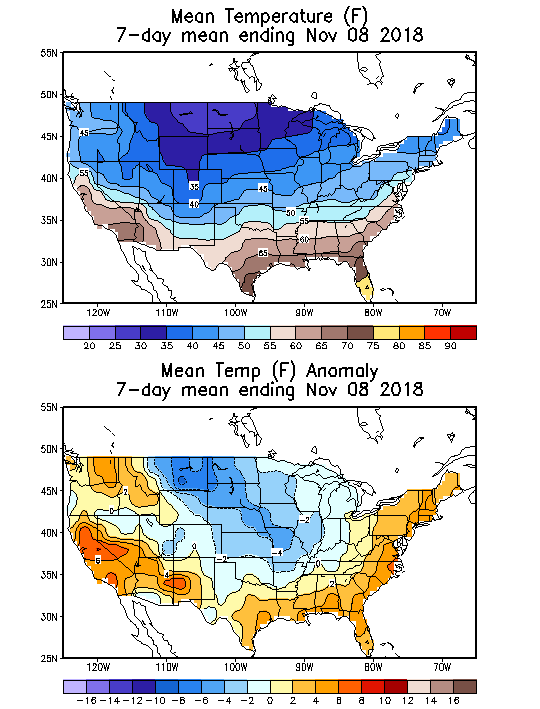
Source: NOAA National Weather Service
Deviation between average and normal (°F)
7-Day Mean ending Nov 08, 2018

Source: NOAA National Weather Service

